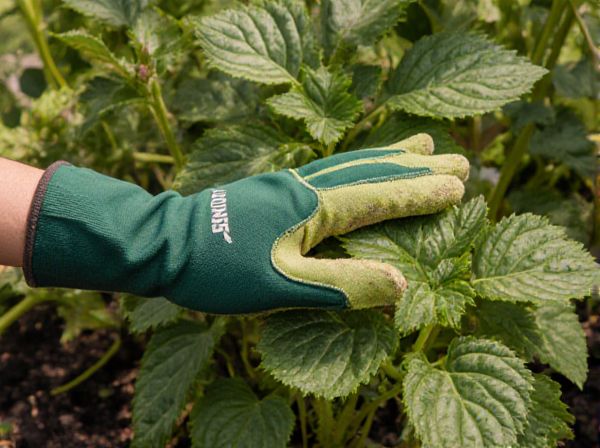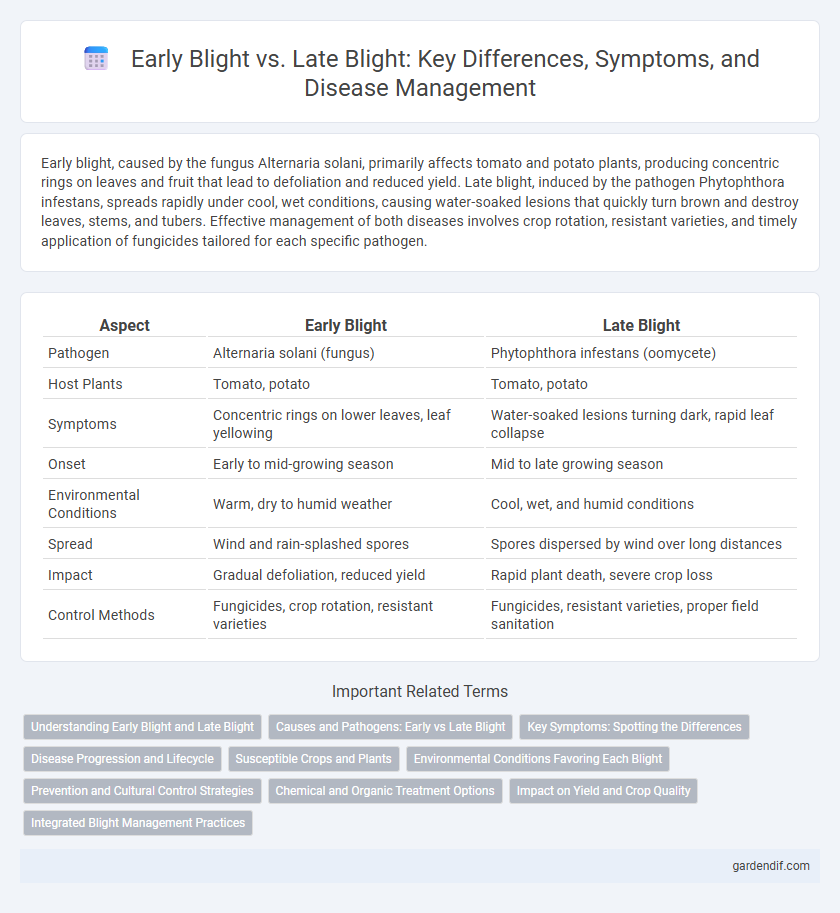
Early blight vs Late blight Illustration
Early blight, caused by the fungus Alternaria solani, primarily affects tomato and potato plants, producing concentric rings on leaves and fruit that lead to defoliation and reduced yield. Late blight, induced by the pathogen Phytophthora infestans, spreads rapidly under cool, wet conditions, causing water-soaked lesions that quickly turn brown and destroy leaves, stems, and tubers. Effective management of both diseases involves crop rotation, resistant varieties, and timely application of fungicides tailored for each specific pathogen.
Table of Comparison
| Aspect | Early Blight | Late Blight |
|---|---|---|
| Pathogen | Alternaria solani (fungus) | Phytophthora infestans (oomycete) |
| Host Plants | Tomato, potato | Tomato, potato |
| Symptoms | Concentric rings on lower leaves, leaf yellowing | Water-soaked lesions turning dark, rapid leaf collapse |
| Onset | Early to mid-growing season | Mid to late growing season |
| Environmental Conditions | Warm, dry to humid weather | Cool, wet, and humid conditions |
| Spread | Wind and rain-splashed spores | Spores dispersed by wind over long distances |
| Impact | Gradual defoliation, reduced yield | Rapid plant death, severe crop loss |
| Control Methods | Fungicides, crop rotation, resistant varieties | Fungicides, resistant varieties, proper field sanitation |
Understanding Early Blight and Late Blight
Early blight, caused by the fungus Alternaria solani, primarily affects tomato and potato plants by creating concentric ring spots on lower leaves, leading to leaf yellowing and defoliation. Late blight, caused by the oomycete Phytophthora infestans, rapidly damages leaves, stems, and tubers with water-soaked lesions and white fungal growth, often resulting in significant crop loss. Understanding the different pathogens, symptoms, and environmental conditions--warm, dry for early blight and cool, wet for late blight--is critical for effective disease management and prevention.
Causes and Pathogens: Early vs Late Blight
Early blight is caused by the fungus Alternaria solani, primarily affecting tomato and potato plants with dark, concentric leaf spots. Late blight is driven by the oomycete Phytophthora infestans, responsible for rapid, destructive damage including water-soaked lesions turning brown to black on leaves and tubers. Understanding these distinct pathogens is crucial for tailored disease management and effective crop protection strategies.
Key Symptoms: Spotting the Differences
Early blight presents as concentric rings forming target-like spots on older leaves, typically causing yellowing around the lesions. Late blight exhibits irregular, water-soaked, dark brown to black lesions that rapidly expand on leaves, stems, and fruit, often accompanied by white fungal growth under humid conditions. Differentiating these symptoms is crucial for timely disease management in tomato and potato crops.
Disease Progression and Lifecycle
Early blight progresses through multiple infection cycles per season, primarily affecting older leaves and producing concentric lesions caused by the fungus Alternaria solani. Late blight, caused by Phytophthora infestans, exhibits rapid disease progression with lesions spreading quickly on leaves, stems, and tubers under cool, wet conditions, often leading to complete crop loss. The early blight lifecycle includes overwintering in crop residue and soil, while late blight produces sporangia that disperse by wind, enabling widespread infection and rapid outbreak development.
Susceptible Crops and Plants
Early blight primarily affects tomato and potato plants, targeting older leaves first and causing characteristic concentric rings on lesions. Late blight is more aggressive, devastating potato and tomato crops by rapidly infecting leaves, stems, and tubers, leading to watery lesions and crop rot. Both diseases thrive in humid conditions but differ in their infection patterns and severity on susceptible crops.
Environmental Conditions Favoring Each Blight
Early blight thrives in warm, humid environments with temperatures between 75degF and 85degF, often exacerbated by prolonged leaf wetness and dense foliage that restricts airflow. Late blight favors cooler, moist conditions, typically between 60degF and 70degF, with frequent rainfall or heavy dew that maintains wetness on leaves and stems. Both diseases proliferate under specific microclimates, influencing the severity and spread of blight in solanaceous crops like tomatoes and potatoes.
Prevention and Cultural Control Strategies
Early blight and late blight, caused by Alternaria solani and Phytophthora infestans respectively, require distinct prevention and cultural control strategies to minimize crop damage. Crop rotation with non-host plants, maintaining proper plant spacing to improve air circulation, and removal of infected plant debris are vital to prevent the spread of early blight. For late blight, resistant cultivars, timely application of fungicides, and avoiding overhead irrigation help reduce disease incidence and severity effectively.
Chemical and Organic Treatment Options
Early blight caused by Alternaria solani and late blight caused by Phytophthora infestans require distinct chemical and organic treatments for effective control. Chemical options such as chlorothalonil, mancozeb, and azoxystrobin are widely used against early blight, while late blight management often involves fungicides like metalaxyl and copper-based compounds. Organic treatments include neem oil, copper fungicides, and biofungicides containing Bacillus subtilis, which help reduce disease severity for both blights while supporting sustainable agricultural practices.
Impact on Yield and Crop Quality
Early blight primarily reduces tomato and potato yield by causing defoliation, leading to decreased photosynthesis and smaller, less marketable fruits. Late blight significantly impacts both yield and crop quality by causing rapid tissue necrosis and fruit rot, often resulting in total crop loss under favorable conditions. Both diseases compromise storage life, but late blight's aggressive progression causes more severe economic damage due to its ability to infect multiple plant parts simultaneously.
Integrated Blight Management Practices
Integrated Blight Management practices for Early blight and Late blight emphasize crop rotation, resistant varieties, and timely fungicide applications tailored to each blight's pathogen biology. Early blight, caused by Alternaria solani, requires management focused on reducing overwintering inoculum through debris removal and optimal irrigation practices to limit leaf wetness. Late blight, driven by Phytophthora infestans, demands close monitoring with predictive models and the use of systemic fungicides to prevent rapid disease spread in conducive humid conditions.
Early blight vs Late blight Infographic

 gardendif.com
gardendif.com